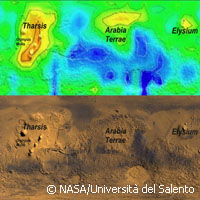A Martian methane mystery
Methane disappears from the atmosphere of Mars in less than a year, according to new research presented at the European Planetary Science Congress (EPSC) in Rome, Italy. The study, by Sergio Fonti of Salento University in Italy and Giuseppe Marzo of NASA (the US National Aeronautics and Space Administration) Ames Research Center, also reveals strong seasonal and geographical variation in methane levels on the red planet. The findings raise questions as to the source of the methane and what happens to it. 'Only small amounts of methane are present in the Martian atmosphere, coming from very localised sources. We've looked at changes in concentrations of the gas and found that there are seasonal and also annual variations,' said Professor Fonti. 'The source of the methane could be geological activity or it could be biological - we can't tell at this point. However, it appears that the upper limit for methane lifetime is less than a year in the Martian atmosphere.' Mars' atmosphere is composed largely of carbon dioxide (95%), plus nitrogen (3%) and argon (1.6%) as well as traces of oxygen and water. The presence of methane in our neighbour's atmosphere was first detected in 2003, and last year astronomers picked up evidence of a seasonal cycle in methane levels. For this study, Professor Fonti and Dr Marzo drew on data from the Thermal Emission Spectrometer (TES) on board NASA's Mars Global Surveyor over three Martian years (one Martian year is almost as long as two Earth years). They were particularly interested in the characteristic spectral features of methane. Their efforts uncovered three regions in Mars' northern hemisphere where methane concentrations are particularly high: Tharsis and Elysium, the two main volcano provinces, and Arabia Terrae, which has high levels of underground water ice. The red planet's methane levels also vary with the seasons. In the northern hemisphere, methane levels peak in the autumn, reaching 70 parts per billion, before falling sharply in winter. Levels start to creep up again in spring and rise rapidly during the summer. In summer, methane levels are higher in the southern hemisphere. The researchers suspect that this could be due to natural circulation in the atmosphere, although this has to be confirmed by computer simulations. 'It's evident that the highest concentrations are associated with the warmest seasons and locations where there are favourable geological - and hence biological - conditions such as geothermal activity and strong hydration,' concludes Professor Fonti. 'The higher energy available in summer could trigger the release of gases from geological processes or outbreaks of biological activity.' This raises the question of what happens to the methane. Photochemical processes could not break down the gas so quickly. However, wind-driven processes could add oxidisers to the atmosphere that could soak up the methane much faster. Further studies are needed to clarify these intriguing issues. The EPSC is organised by the EU-funded EUROPLANET initiative and is the major meeting in Europe for planetary scientists. EUROPLANET is funded by the EU under the Research Infrastructures budget line of the Seventh Framework Programme (FP7). Its goal is to bring together Europe's planetary science community through networking and joint research activities and by providing scientists with access to specialised laboratories and facilities as well as planetary science data, information and software tools.
Countries
Italy, United States



